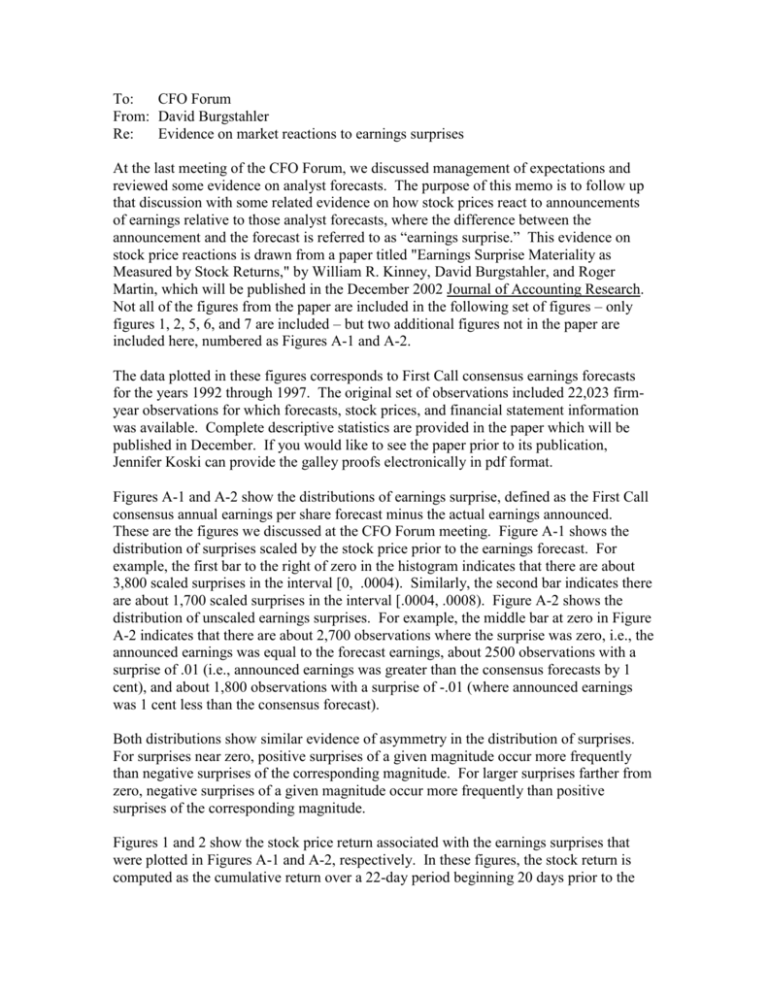"Earnings Surprise Materiality as Measured by Stock Returns," which
advertisement

To: CFO Forum From: David Burgstahler Re: Evidence on market reactions to earnings surprises At the last meeting of the CFO Forum, we discussed management of expectations and reviewed some evidence on analyst forecasts. The purpose of this memo is to follow up that discussion with some related evidence on how stock prices react to announcements of earnings relative to those analyst forecasts, where the difference between the announcement and the forecast is referred to as “earnings surprise.” This evidence on stock price reactions is drawn from a paper titled "Earnings Surprise Materiality as Measured by Stock Returns," by William R. Kinney, David Burgstahler, and Roger Martin, which will be published in the December 2002 Journal of Accounting Research. Not all of the figures from the paper are included in the following set of figures – only figures 1, 2, 5, 6, and 7 are included – but two additional figures not in the paper are included here, numbered as Figures A-1 and A-2. The data plotted in these figures corresponds to First Call consensus earnings forecasts for the years 1992 through 1997. The original set of observations included 22,023 firmyear observations for which forecasts, stock prices, and financial statement information was available. Complete descriptive statistics are provided in the paper which will be published in December. If you would like to see the paper prior to its publication, Jennifer Koski can provide the galley proofs electronically in pdf format. Figures A-1 and A-2 show the distributions of earnings surprise, defined as the First Call consensus annual earnings per share forecast minus the actual earnings announced. These are the figures we discussed at the CFO Forum meeting. Figure A-1 shows the distribution of surprises scaled by the stock price prior to the earnings forecast. For example, the first bar to the right of zero in the histogram indicates that there are about 3,800 scaled surprises in the interval [0, .0004). Similarly, the second bar indicates there are about 1,700 scaled surprises in the interval [.0004, .0008). Figure A-2 shows the distribution of unscaled earnings surprises. For example, the middle bar at zero in Figure A-2 indicates that there are about 2,700 observations where the surprise was zero, i.e., the announced earnings was equal to the forecast earnings, about 2500 observations with a surprise of .01 (i.e., announced earnings was greater than the consensus forecasts by 1 cent), and about 1,800 observations with a surprise of -.01 (where announced earnings was 1 cent less than the consensus forecast). Both distributions show similar evidence of asymmetry in the distribution of surprises. For surprises near zero, positive surprises of a given magnitude occur more frequently than negative surprises of the corresponding magnitude. For larger surprises farther from zero, negative surprises of a given magnitude occur more frequently than positive surprises of the corresponding magnitude. Figures 1 and 2 show the stock price return associated with the earnings surprises that were plotted in Figures A-1 and A-2, respectively. In these figures, the stock return is computed as the cumulative return over a 22-day period beginning 20 days prior to the announcement of earnings, extending up through the day of announcement of earnings and ending 1 day after the announcement. Each cumulative return is adjusted for the return on the market. Each figure depicts the distribution of cumulative market-adjusted returns associated with a given level of earnings surprise by the mean and median return (shown as a hollow circle and a solid circle, respectively) and by the 33.3 and 66.7 percentiles of the distribution of returns, and each tick mark on the vertical axis represents a return of .0075, i.e., 3/4 of 1%. To illustrate how to read these figures consider in Figure 1 the column of symbols plotted on the vertical axis (corresponding to zero earnings surprises). These symbols show that the mean return associated with a zero surprise is less than .0075, say about .005, the median return associated with a zero surprise is about -.0025, the 33.3 percentile is about -.04, and the 66.7 percentile is about +.04. Thus, when earnings are announced equal to forecast earnings, the mean and median return are typically close to zero, in about 1/3 of the cases the return is more negative than -4%, and in about 1/3 of the cases the return is greater than 4%. As another example, moving just to the right of the vertical axis, the first column of symbols depicts the distribution of returns associated with the 500 smallest positive scaled earnings surprises. For these 500 observations, the mean and median cumulative adjusted return are each just slightly greater than 0, the 33.3 percentile is about -.02 and the 66.7 percentile is about .03. Thus, for the smallest positive earnings surprises, the mean and median returns are slightly positive, in about 1/3 of the cases the return is less than -2%, and in about 1/3 of the cases the return is greater than 3%. The remaining symbols in the figure show the distributions of returns associated with groups (or portfolios) of 500 observations where the groups have been formed by sorting earnings surprises into portfolios consisting of similar-sized earnings surprises. For example, the next column of symbols to the right of our last example shows the distribution of returns corresponding to the next 500 smallest earnings surprises. Overall, Figure 1 shows an S-shaped relation between earnings surprise and returns. The mean and median return almost always have the same sign as the sign of the surprise, though for every level of surprise, in more than 1/3 of the cases the returns have a sign opposite the sign of the surprise. Larger magnitude surprises tend to be associated with larger magnitude returns. However, as the magnitude of surprise increases, the magnitude of returns increases less than proportionally. Figure 2 also depicts the distribution of returns associated with different levels of earnings surprise, but in Figure 2 earnings surprise is unscaled. By definition, the group of 0 cent earnings surprises in Figure 2 is exactly the same as the group of 0 scaled earnings surprises in Figure 1, and therefore the distribution shown for the zero surprises in Figure 2 is exactly the same as for zero surprises in Figure 1. However, the other portfolios differ between Figures 1 and 2. In Figure 2, portfolios are formed based on cents of unscaled earnings surprise. For example, the first column to the right of the vertical axis represents the distribution of returns for all 1 cent positive surprises and the first column to the left of the vertical axis represents the distribution of returns for all 1 cent negative surprises. As indicated in the title of Figure 2, for surprises more negative than –10 cents or more positive than 10 cents, portfolios are formed to include more than a single cent of surprise. (Details of this process are explained in the paper.) For surprises of +.01, the mean and median return are in the vicinity of .01, the 33.3 percentile is about -.02 and the 66.7 percentile is about .05. For surprises of -.01, the mean and median return are slightly less than zero, the 33.3 percentile is about -.04 and the 66.7 percentile is about .03. In summary, Figures 1 and 2 show that anecdotes of large prices responses to small earnings surprises are drawn from the extremes of the distribution of returns, and do not represent the typical stock price response. Instead, the average price response (as reflected in the mean and median) is typically on the order of a few percent (even for large surprises). Moreover, returns of a sign opposite the sign of the earnings surprise are commonplace. Finally, Figures 5, 6, and 7 explore an explanation for the S-shaped relation between earnings surprise and returns. These three figures show the relation for three subsets of the original data. To formulate these figures, observations are sorted into three groups based on the dispersion among the individual forecasts comprised by the consensus forecast. Figure 5 shows the relation for those observations with low dispersion among the individual forecasts, Figure 7 shows observations with high dispersion among the forecasts, and Figure 6 shows observations with dispersion in between the two extremes. Two main features are apparent from the figures. First, the magnitude of surprises is directly related to the dispersion in forecasts. For example, in Figure 5 where there is low dispersion and analysts largely agree on forecasts of earnings, it is uncommon to observe large surprises. As dispersion increases in Figures 6 and 7 where there is increasing disagreement about forecasts of earnings, larger surprises become increasingly common. (This relation is explored in more detail in the published version of the paper.) Second, the relation between returns and surprises is nearly linear within dispersion groups, and the slope of the linear relation is strongly related to dispersion. For low dispersion in Figure 5, the slope of the relation is approximately 30 over the range of common earnings surprises. For moderate dispersion, the slope of the relation is approximately 10. For high dispersion, the slope of the relation is about 1 or 2. (These estimates are drawn from regression analysis reported in detail in the published paper.) Because surprise is scaled by beginning price and returns are the change in price scaled by beginning price, the slope of the relation is a measure of the sensitivity of price to earnings. Assuming a simple model where price is a multiple of expected earnings, the slope of the relation is the multiple times the change in expected earnings due to the announcement of earnings. Under this assumption, the results suggest that expected earnings change by approximately the amount of the earnings surprise in the low dispersion case, but by progressively less than the amount of earnings surprise for progressively higher dispersion. That is, the amount of revision in expectations of future earnings is related to dispersion among analyst forecasts, i.e., to the amount of agreement among analysts as to expected earnings. When there is high agreement (as in Figure 5), earnings surprises appear to lead to revisions of expected earnings approximately as large as the earnings surprise, because the slope of the relation is approximately equal to typical price-earnings ratios. As we move to lower agreement among analysts (in Figure 6 and then Figure 7), the fact that the slope of the relation moves progressively lower suggests that earnings surprises lead to progressively smaller revisions in expected earnings as agreement becomes progressively lower.







